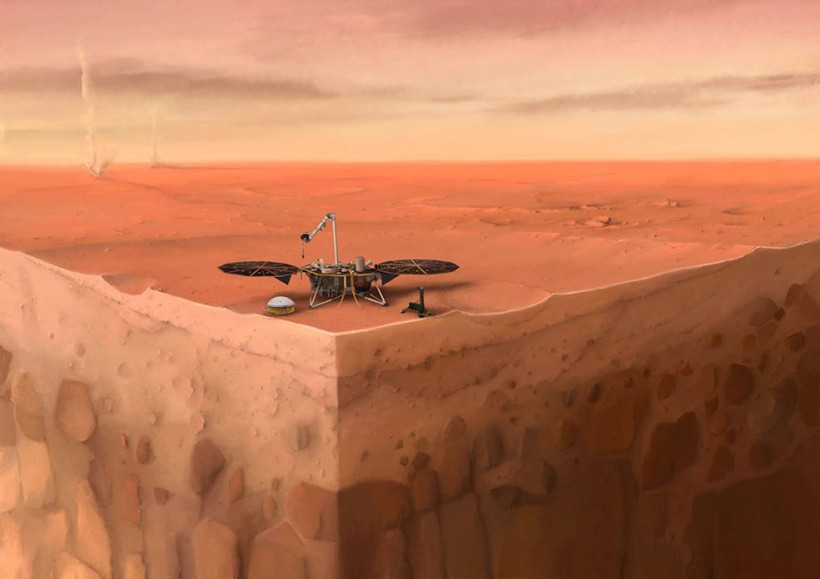The National Aeronautics and Space Administration (NASA) proclaimed the Mars Digger dead or defunct. The so-called Mole component of the InSight lander mission failed to dig far enough into the red planet to take its temperature.
The heat probe built and constructed by the German Aerospace Center (DLR) attempted to dig tunnels into the Martian surface to take its inner temperature. It was expected to offer data on what drives the formation and geology of Mars.

In this artist's concept of NASA's InSight lander on Mars, layers of the planet's subsurface can be seen below, and dust devils can be seen in the background.
But the soil's sudden propensity to clump had robbed the spike-like mole of the traction needed to hammer itself to an appropriate depth. In the red earth, the 16-in-long system that belongs to Nasa's InSight lander did not achieve ample friction.
Are We Going to Call It Quits?
The “mole,” a heat probe that traveled to Mars aboard NASA’s InSight lander, as it looked after hammering on Jan. 9, 2021, the 754th Martian day, or sol, of the mission. After trying since Feb. 28, 2019, to bury the probe, the mission team called an end to their efforts.
The squad called it quits following one more futile effort to pound itself down over the weekend with 500 moves.
The lead scientist for the experiment, Tilman Spohn of the German Space Agency, told the Associated Press (AP) that they had offered everything they had. "Still, Mars and our valiant mole remain incompatible."
The initiative would be useful for potential Mars exploration activities, he said.
According to NASA, explorers may one day need to dig through Mars to pursue frozen water to drink or create oxygen, or evidence of past microscopic existence.
The architecture of the mole focused on Martian soil studied by past spacecraft. This turned out to be nothing like the clumpy soil discovered this time around.
Meanwhile, InSight's French seismometer has reported almost 500 Marsquakes. The lander's weather station also provides regular forecasts.
Hard-Earned Wisdom
Scientists would be confused for years to come by the soil's unexplained properties at the surface next to InSight. The teams worked for two years to adjust the unique and creative tool to these modern situations.
Troy Hudson, a scientist and engineer at NASA's Southern California Jet Propulsion Laboratory, said the mole is a heritage-less system. Hudson, who led attempts to bring the mole further into the Martian surface, added that it was unusual to try to dig so deep with a system so thin.
Besides knowing more about the terrain at this site, engineers who acquired valuable expertise worked on the robotic arm. In reality, at the start of the mission, they used the arm and pick in ways they never planned, like pushing against and downward on the mole. The output was developed by arranging the movements and correcting the orders they submitted to InSight.
The project aims to use the robotic arm to bury the tether that transmits data and power between both the lander and InSight's seismometer. Burying it would further mitigate temperature variations that in seismic data have caused cracking and popping noises.
InSight, short for Interior Discovery utilizing Seismic Investigations, Geodesy, and Heat Transfer, has far more research to come from. Recently, NASA continued the mission to Dec. 2022 or for two more years.
The lander houses a radio experiment and devices for hunting quakes, which gathers data to reveal whether the center of the planet is liquid or strong. The weather sensors of InSight are also capable of delivering some of the most accurate meteorological data ever obtained on Mars.
The three spacecraft will establish the first meteorological network on another world alongside weather instruments onboard NASA's Curiosity rover and its new Perseverance rover, which lands on Feb. 18.
ALSO READ: Jupiter's Icy Moon Europa 'Glows in the Dark' Due to Radiation, Scientists Say
Check out more news and information on Space on Science Times.










!['Cosmic Glitch' in Einstein's Theory of General Relativity Could Be Explained in This New Scientific Tweak [Study]](https://1721181113.rsc.cdn77.org/data/thumbs/full/53435/258/146/50/40/cosmic-glitch-in-einsteins-theory-of-general-relativity-could-be-explained-in-this-new-scientific-tweak-study.jpeg)



